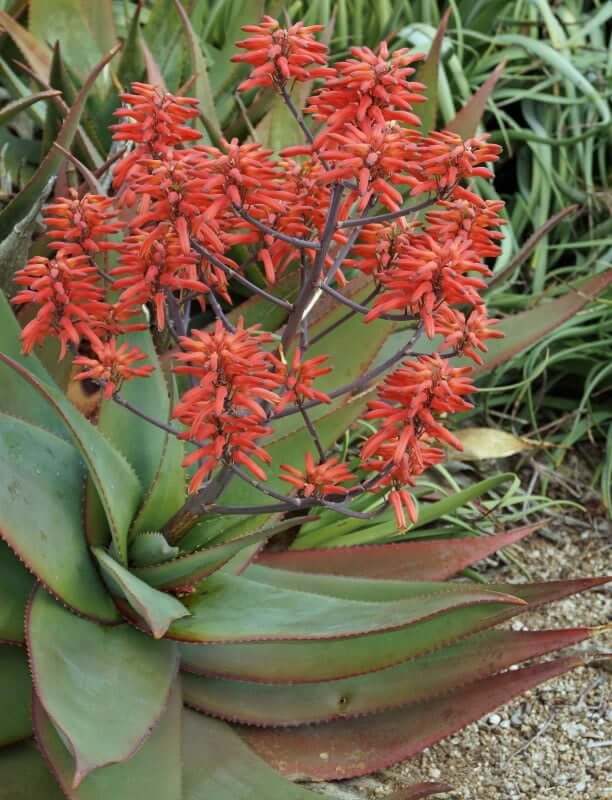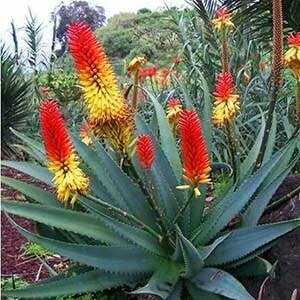Aloes are gaining popularity in South African gardens for all the right reasons like low maintenance, not water-thirsty, hardy, and they make wonderful focal points in an African landscape as a result of their magnificent structures, forms and shapes. The variety in colours, sizes and designs astound!
Just because they are so versatile and undemanding, they cannot be totally neglected in the garden. With a lot less love, care and attention than most other plants they will reward many drab late autumn and winter gardens with flowers of magnificent splendour and feed a host of beneficial creatures like sunbirds and bees with nectar.

1. TIPS FOR GROWING ALOES
- Aloes could be unhealthy and stressed by excess watering in mixed gardens that are on automated irrigation systems. So be sure to group plantings according to their water requirements when designing the irrigation system.
- If soils become waterlogged and do not drain freely, Aloes often develop root rot.
- Plant Aloes in areas where the soil is sandy or rocky and free draining. You might need to create these conditions in the planting area by adding rocks, sand and twigs in clay or dense soils.
- Choose the correct variety to suit your climate – some varieties of Aloes might be frost sensitive; others tolerate freezing conditions.
- Aloes prefer a sunny spot in the garden but can take filtered shade for part of the day.

2. PLANTING ALOES IN SOIL & CONTAINERS
- Research the best Aloe variety for planting position, size and effect such as whether it will be grouped in a garden bed, or planted in containers, or whether a single aloe or aloes will be placed as feature points in the garden. The varieties range from small to tall, with single colour or multi-coloured flowers, and striped, speckled or plain leaves to achieve an exciting display.
- Dig a square hole with adequate space to fit the root ball. Remove container and carefully place the Aloe into the hole. Support large Aloes with a wooden stake to keep the plant upright and to prevent damage while planting.
- Mix the following with topsoil and fill planting hole:
- 1 to 3L of good quality compost,
- 250ml of worm castings and
- 10ml (small Aloe) to 100ml (large Aloe) organic fertilizer.
- When planting Aloes in containers, mix the above conditioners into the soil or growing medium, plant the Aloe and fill the container to cover root ball.
- Water well, every week or 2 until roots settle and establish. Then reduce to occasional watering as required in growing climate.

3. FEEDING ESTABLISHED ALOES
- Fertilize Aloes after their flowering season ends.
- In the Autumn months of February to April prepare them for flowering by fertilizing. This will also build strong cells to resist disease on roots and leaves.

4. DISEASE CONTROL IN ALOES
- In very wet or dry conditions the Aloes planting area can be drenched to strengthen against root rots and drought stress.Disease conditions in Aloes are usually root rots, galls, and cankers, often symptoms of distress which makes the plant vulnerable to attacks of bacteria, fungus or virus that might be present in the environment such as soil pathogens, cross contamination from other plants during propagation or by wind or waterborne spores.
- Cut off leaves and stems that are infected with diseases and burn if possible.
- Fertilize by spreading organic fertilizer and compost or a thin layer of worm castings over soil surface to condition soil and promote plant health.

5. PEST CONTROL IN ALOES
- Pests most likely to attack Aloes are snout beetles, white scale, mealy bug and ants. Identify the cause of distress, which will often be caused by hungry, unfed plants. Just because Aloes are hardy does not mean that they are not hungry. Imagine the amount of nutrients that go into building the fine structures of Aloes.
- Feed them up as suggested to maintain these magnificent bodies in fine form and at the same time resist pest attack!
- Where pest attack is present, try to start treatment as early as possible for best results, especially before Snout Beetle larvae can burrow into core and stems of plant.
- Spray leaves and stems with organic pesticides in the late afternoon. This will smother and kill the responsible pest and denature their eggs, without poisoning people, pets and the environment.
- Control ants by drenching soil around the plant with an organic pesticide mixture. Ants are often responsible for carrying scales, mealy bug and aphids onto distressed plants, so use them as signs of problems to come.
Remember, with all pest and disease conditions in plants, prevention is easier and better than cure!


